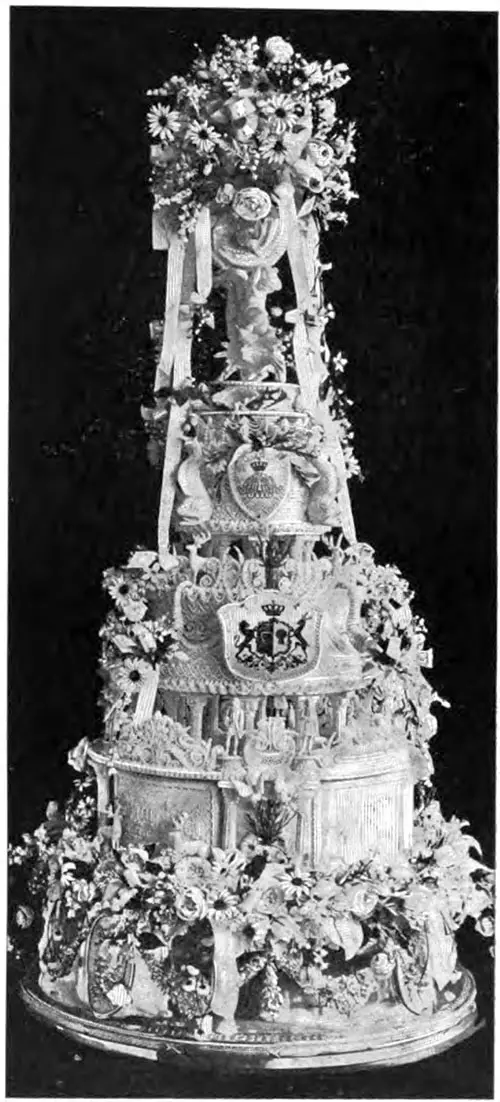Royal Wedding Cakes - 1904

Wedding Cake of Prince and Princess Adolphus of Teck
One English firm has long made the wedding cake for all the weddings in the royal family. This prestigious firm, patronized by Queen Victoria and the English nobility, owes its success to the fact that a box of cakes, given by its founder, Richard Bolland, to the Queen, when she was a young princess, in 1835. The Queen was so pleased that later the cakes made by Bolland, were branded made "by royal warrant purveyors to Her Majesty Queen Victoria and His Royal Highness the Prince of Wales."
At the wedding of King Edward's daughter, Princess Maud of Wales, twelve cakes were sent to notable relatives who could not be present.
Here is the recipe, with its very novel almond icing, said to be that which was used for the Royal Wedding Cake:
- One pound and a half of butter
- One pound and a half of flour
- One pound of sugar
- One pound of dried cherries, slightly chopped
- One pound and a half of currants
- One pound and a half of candied orange, lemon, and citron peel in equal quantities, all of these to be shredded very fine.
- Eight ounces of pounded almonds
- Twelve whole eggs
- The rinds of four oranges rubbed on sugar
- Half an ounce of ground spices, consisting of cinnamon, cloves, and nutmeg, mixed in equal proportions
- A teaspoon of salt
- Half a pint of old brown brandy
All these delicious things are to be combined in the following manner:
- In a large earthen cake or mixing-bowl place the butter, and cream it with a wooden spoon.
- Next add, gradually, the sugar, flour, and eggs, continuing to blend them with the butter steadily.
- When these have been thoroughly mixed, the cherries, currants, candied peel, ground almonds, brandy, salt, and spices must be added gradually; and, when all of them have been very thoroughly incorporated with the batter, the whole mass is to be poured into a pan that has been previously lined with buttered paper.
- After the long, slow, and steady baking that all such cake requires, it must be iced, when wanted.
At the Bollands', the cakes are kept at least six months to season; and thousands of pounds are kept on hand ready for shipment, on sudden orders from any colony or country around the globe,—Australia, India, or America.
A Boston woman caterer has cakes on hand during the summer for quick use, but does not frost them until wanted, as, she says, the frosting darkens from contact with the cake.
Royal Icing
The above cake is to be iced, first, with an almond icing:
- Mix eight ounces of very fine-powdered almonds with double that quantity of sifted sugar, a little orange-flower water, and sufficient whites of eggs to form the whole into a soft paste.
- Spread a coating of this all over the surface of the cake, and, when it has become cold and hard, a second and different icing is to be put on over this one.
- To make it, take eight whites of new-laid eggs in a large-sized basin, and add a pound and a half of sifted sugar and work together with a wooden spoon, adding now and then a little-strained lemon juice, until the whole compound has a thick, shiny substance.
- This icing must cover the first one at least a quarter of an inch deep and be dried in a warm atmosphere.

Wedding Cake of Princess Maud of Wales
A new fashion in wedding cakes was introduced by the one provided for Princess Maud of Wales. Instead of the dead-white decorations hitherto considered the proper thing, almond paste, caramel and other delicate tints were introduced in the wreaths and monograms adorning the handsome three-tier cake.
Besides the twelve cakes made by this recipe for the absent royalties, there was the grand one for the wedding banquet, tall and graceful and exquisite, combining the arms of England and Denmark.
Each tier was encircled with white satin ribbons, bordered with pearls, and ornamented with bridal buds and true lovers' knots, and surmounted by the god of love holding a nautilus shell, from which fell in long lines silver bullion and sea mosses.
The shell held roses and starry bridal flowers; and around the base, richly emblazoned with the royal arms, was a wreath of the same flowers.
Even a fairy princess could ask for no more charming and superb cake than this. For each succeeding royal marriage, an appropriate design is made for the majestic cake, with heraldic devices and fitting emblems.
Julia Davis Chandler, "Wedding Cake," in The Boston Cooking School Magazine of Culinary Science & Domestic Economics, Vol. IX, No. 1, June-July 1904, p. 3-5, xii.
